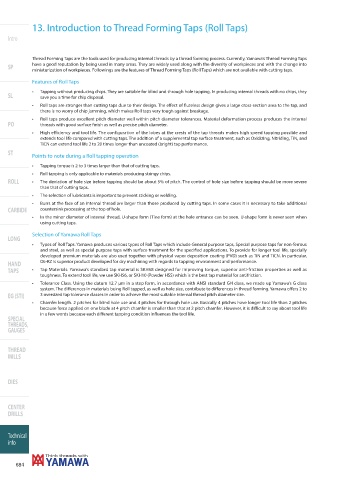Page 686 - Yamawa_European_Catalogue_YEU21
P. 686
13. Introduction to Thread Forming Taps (Roll Taps)
Intro
Thread Forming Taps are the tools used for producing internal threads by a thread forming process. Currently, Yamawa’s Thread Forming Taps
have a good reputation by being used in many areas. They are widely used along with the diversity of workpieces and with the change into
SP
miniaturization of workpieces. Followings are the features of Thread Forming Taps (Roll Taps) which are not available with cutting taps.
Features of Roll Taps
• Tapping without producing chips. They are suitable for blind and through hole tapping. In producing internal threads with no chips, they
SL save you a time for chip disposal.
• Roll taps are stronger than cutting taps due to their design. The eff ect of fl uteless design gives a large cross-section area to the tap, and
there is no worry of chip jamming, which makes Roll taps very tough against breakage.
• Roll taps produce excellent pitch diameter well within pitch diameter tolerances. Material deformation process produces the internal
PO threads with good surface fi nish as well as precise pitch diameter.
• High efficiency and tool life. The configuration of the lobes at the crests of the tap threads makes high speed tapping possible and
extends tool life compared with cutting taps. The addition of a supplemental tap surface treatment, such as Oxidizing, Nitriding, TiN, and
TiCN can extend tool life 2 to 20 times longer than uncoated (bright) tap performance.
ST
Points to note during a Roll tapping operation
• Tapping torque is 2 to 3 times larger than that of cutting taps.
• Roll tapping is only applicable to materials producing stringy chips.
ROLL • The deviation of hole size before tapping should be about 5% of pitch. The control of hole size before tapping should be more severe
than that of cutting taps.
• The selection of lubricants is important to prevent sticking or welding.
• Burrs at the face of an internal thread are larger than those produced by cutting taps. In some cases it is necessary to take additional
CARBIDE countersink processing at the top of hole.
• In the minor diameter of internal thread, U-shape form (Tine form) at the hole entrance can be seen. U-shape form is never seen when
using cutting taps.
Selection of Yamawa Roll Taps
LONG
• Types of Roll Taps. Yamawa produces various types of Roll Taps which include General purpose taps, Special purpose taps for non-ferrous
and steel, as well as special purpose taps with surface treatment for the specifi ed applications. To provide for longer tool life, specially
developed premium materials are also used together with physical vapor deposition coating (PVD) such as TiN and TiCN. In particular,
HAND OL-RZ is superior product developed for dry machining with regards to tapping environment and performance.
TAPS • Tap Materials. Yamawa’s standard tap material is SKH58 designed for improving torque, superior anti-friction properties as well as
toughness. To extend tool life, we use SKH56, or SKH10 (Powder HSS) which is the best tap material for antifriction.
• Tolerance Class. Using the datum 12.7 μm in a step form, in accordance with ANSI standard GH class, we made up Yamawa’s G class
system. The diff erences in materials being Roll tapped, as well as hole size, contribute to diff erences in thread forming. Yamawa off ers 2 to
EG (STI) 3 oversized tap tolerance classes in order to achieve the most suitable internal thread pitch diameter size.
• Chamfer length. 2 pitches for blind hole use and 4 pitches for through hole use. Basically 4 pitches have longer tool life than 2 pitches
because force applied on one blade at 4 pitch chamfer is smaller than that at 2 pitch chamfer. However, it is diffi cult to say about tool life
in a few words because each diff erent tapping condition infl uences the tool life.
SPECIAL
THREADS,
GAUGES
THREAD
MILLS
DIES
CENTER
DRILLS
Technical
info
684

